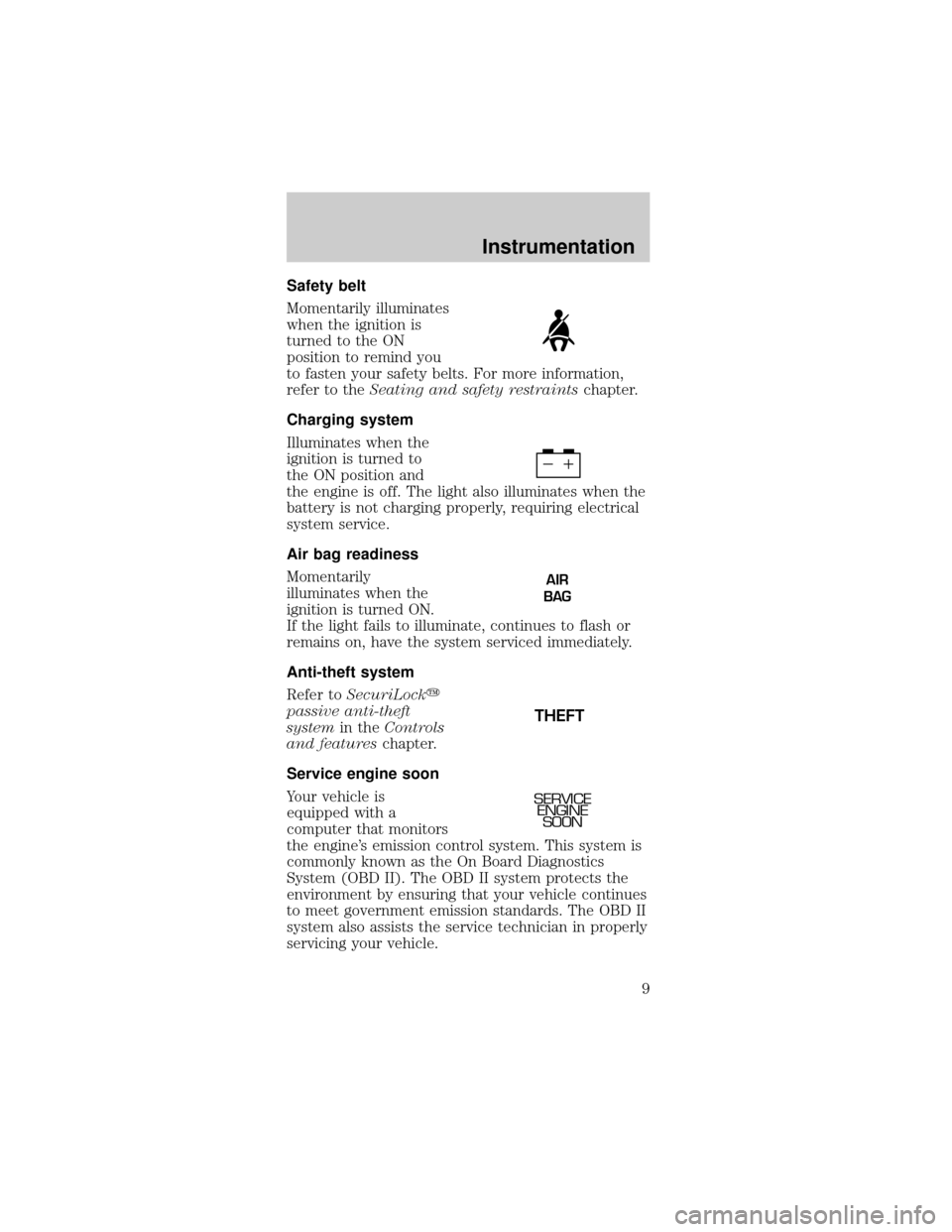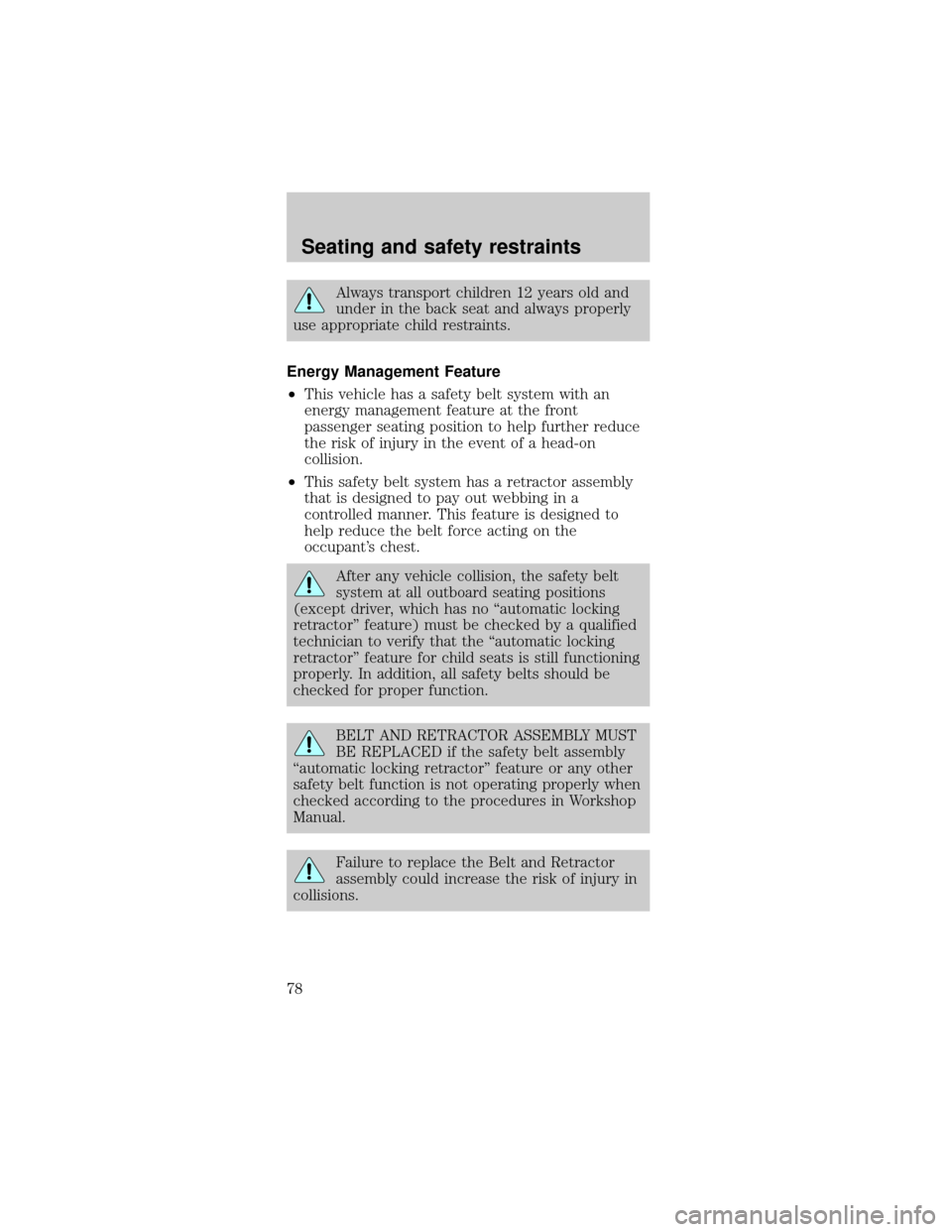Page 4 of 240
These are some of the symbols you may see on your
vehicle.
Vehicle Symbol Glossary
Safety Alert
See Owner's Guide
Fasten Safety BeltAir Bag-Front
Air Bag-SideChild Seat
Child Seat
Installation WarningChild Seat Tether
Anchorage
Brake SystemAnti-Lock Brake
System
Brake Fluid -
Non-Petroleum
BasedTraction Control
Master Lighting
SwitchHazard Warning
Flasher
Fog Lamps-FrontFuse Compartment
Fuel Pump ResetWindshield
Wash/Wipe
Windshield
Defrost/DemistRear Window
Defrost/Demist
Introduction
4
Page 9 of 240

Safety belt
Momentarily illuminates
when the ignition is
turned to the ON
position to remind you
to fasten your safety belts. For more information,
refer to theSeating and safety restraintschapter.
Charging system
Illuminates when the
ignition is turned to
the ON position and
the engine is off. The light also illuminates when the
battery is not charging properly, requiring electrical
system service.
Air bag readiness
Momentarily
illuminates when the
ignition is turned ON.
If the light fails to illuminate, continues to flash or
remains on, have the system serviced immediately.
Anti-theft system
Refer toSecuriLocky
passive anti-theft
systemin theControls
and featureschapter.
Service engine soon
Your vehicle is
equipped with a
computer that monitors
the engine's emission control system. This system is
commonly known as the On Board Diagnostics
System (OBD II). The OBD II system protects the
environment by ensuring that your vehicle continues
to meet government emission standards. The OBD II
system also assists the service technician in properly
servicing your vehicle.
AIR
BAG
THEFT
SERVICE
ENGINE
SOON
Instrumentation
9
Page 13 of 240

Brake system warning
Momentarily illuminates
when the ignition is
turned to the ON
position to ensure the
circuit is functional. Also illuminates if the parking
brake is engaged. If brake warning lamp does not
illuminate at these times, seek service immediately.
Illumination after releasing the parking brake
indicates low brake fluid level and the brake system
should be inspected immediately.
Safety belt warning chime
Sounds to remind you to fasten your safety belts.
For information on the safety belt warning chime,
refer to theSeating and safety restraintschapter.
Belt minder chime
Sounds intermittently to remind you to fasten your
safety belts.
For information on the safety belt minder chime,
refer to theSeating and safety restraintschapter.
Supplemental restraint system (SRS) warning
chime
For information on the SRS warning chime, refer to
theSeating and safety restraintschapter.
Key-in-ignition warning chime
Sounds when the key is left in the ignition in the
OFF/LOCK or ACC position and the driver's door is
opened.
Headlamps on warning chime
Sounds when the headlamps or parking lamps are
on, the ignition is off (and the key is not in the
ignition) and the driver's door is opened.
P!
BRAKE
Instrumentation
13
Page 73 of 240
SEATING
Adjustable head restraints (if equipped)
Your vehicle's seats may be equipped with head
restraints which are vertically adjustable. The
purpose of these head restraints is to help limit head
motion in the event of a rear collision. To properly
adjust your head restraints, lift the head restraint so
that it is located directly behind your head or as
close to that position as possible. Refer to the
following to raise and lower the head restraints.
The head restraints can
be moved up and
down.
Adjusting the front manual seat
Never adjust the driver's seat or seatback
when the vehicle is moving.
Do not pile cargo higher than the seatbacks
to reduce the risk of injuring people in a
collision or sudden stop.
Always drive and ride with your seatback
upright and the lap belt snug and low across
the hips.
Reclining the seatback can reduce the
effectiveness of the seat's safety belt in the
event of a collision.
Seating and safety restraints
73
Page 74 of 240
Lift handle to move
seat forward or
backward.
Pull lever up to adjust
seatback.
Adjusting the front power seat (if equipped)
Never adjust the driver's seat or seatback
when the vehicle is moving.
Do not pile cargo higher than the seatbacks
to avoid injuring people in a collision or
sudden stop.
Always drive and ride with your seatback
upright and the lap belt snug and low across
the hips.
Reclining the seatback can reduce the
effectiveness of the seat's safety belt in the
event of a collision.
Seating and safety restraints
74
Page 76 of 240
The rotating boot on the front seat belt is designed
to allow rear seat entry/exit. To enter the rear seat:
1. Remove seat belt
from seat belt holder
on top of front seat.
2. Rotate the safety
belt boot rearward.
3. Enter the rear seat in front of the safety belt.
4. Rotate the safety belt boot forward and place the
belt in the belt guide on the seat back to allow use
by the front driver/passenger.
2nd seat/Split-folding rear seat (if equipped)
One or both rear seatbacks can be folded down to
provide additional cargo space.
To lower the
seatback(s) from inside
the vehicle, pull tab to
release seat back and
then fold seatback
down.
When raising the seatback(s), make sure you hear
the seat latch into place.
SAFETY RESTRAINTS
Safety restraints precautions
Always drive and ride with your seatback
upright and the lap belt snug and low across
the hips.
Seating and safety restraints
76
Page 77 of 240

To reduce the risk of injury, make sure
children sit where they can be properly
restrained.
Never let a passenger hold a child on his or
her lap while the vehicle is moving. The
passenger cannot protect the child from injury in a
collision.
All occupants of the vehicle, including the
driver, should always properly wear their
safety belts, even when an air bag SRS is provided.
It is extremely dangerous to ride in a cargo
area, inside or outside of a vehicle. In a
collision, people riding in these areas are more
likely to be seriously injured or killed. Do not allow
people to ride in any area of your vehicle that is
not equipped with seats and safety belts. Be sure
everyone in your vehicle is in a seat and using a
safety belt properly.
In a rollover crash, an unbelted person is
significantly more likely to die than a person
wearing a safety belt.
Each seating position in your vehicle has a
specific safety belt assembly which is made
up of one buckle and one tongue that are designed
to be used as a pair. 1) Use the shoulder belt on
the outside shoulder only. Never wear the shoulder
belt under the arm. 2) Never swing the safety belt
around your neck over the inside shoulder. 3)
Never use a single belt for more than one person.
Seating and safety restraints
77
Page 78 of 240

Always transport children 12 years old and
under in the back seat and always properly
use appropriate child restraints.
Energy Management Feature
²This vehicle has a safety belt system with an
energy management feature at the front
passenger seating position to help further reduce
the risk of injury in the event of a head-on
collision.
²This safety belt system has a retractor assembly
that is designed to pay out webbing in a
controlled manner. This feature is designed to
help reduce the belt force acting on the
occupant's chest.
After any vehicle collision, the safety belt
system at all outboard seating positions
(except driver, which has no ªautomatic locking
retractorº feature) must be checked by a qualified
technician to verify that the ªautomatic locking
retractorº feature for child seats is still functioning
properly. In addition, all safety belts should be
checked for proper function.
BELT AND RETRACTOR ASSEMBLY MUST
BE REPLACED if the safety belt assembly
ªautomatic locking retractorº feature or any other
safety belt function is not operating properly when
checked according to the procedures in Workshop
Manual.
Failure to replace the Belt and Retractor
assembly could increase the risk of injury in
collisions.
Seating and safety restraints
78